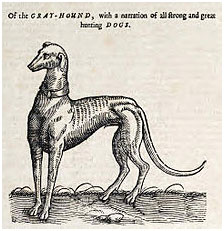The Greyhound and the Three Greyhounds Inn
Origins are uncertain but it is thought the Greyhound developed from ancient Egyptian ‘sight hounds’ dogs such as a Sloughi which hunt with their sight as opposed to their scent. Sometimes called ‘gaze’ hounds.The presence of the Greyhound in Britain dates back to 900AD and since Anglo-Saxon times these hounds have been connected with the English monarchy and later to the gentry and prosperous landowners. The Greyhound was used for hunting wild boar and deer when such activities were exclusive to the royal estates.
Since then the dog has been used for coursing hare and other smaller game. The Greyhound is also known as a racing dog and is one of the fastest dogs, if not the fastest, in existence, capable of speeds over 40 miles per hour!! The only other animal that can accelerate faster over a short distance is the cheetah, which can reach speeds of 109 kilometres per hour (68 mph) over 3-4 strides from a standing start.
A Greyhound is a friendly and affectionate dog and tends to be reasonably inactive when indoors. However it requires good long daily exercise with the opportunity to run freely.
The name the ‘Three Greyhounds’ we believe was adopted to recognise the prosperous landowner whose farm was converted to a country inn around 300 years ago.  Traditionally in many famous pictures, as below, three Greyhounds signified wealth and real hunting pedigree. It is known that in England during the medieval period, lords and royalty keen to own Greyhounds for sport requested they be bred to colour variants that made them easier to view and identify in pursuit of their quarry and this is reflected in the picture on our menus.
Traditionally in many famous pictures, as below, three Greyhounds signified wealth and real hunting pedigree. It is known that in England during the medieval period, lords and royalty keen to own Greyhounds for sport requested they be bred to colour variants that made them easier to view and identify in pursuit of their quarry and this is reflected in the picture on our menus.
The name “Greyhound” is generally believed to come from the Old English grighund. “Hund” is the antecedent of the modern “hound”, but the meaning of “grig” is undetermined, other than in reference to dogs in Old English and Old Norse. Its origin does not appear to have any common root with the modern word “grey” for color, and indeed the Greyhound is seen with a wide variety of coat colors. The Greyhound is the only dog mentioned by name in the Bible; many versions, including the King James version, name the Greyhound as one of the “four things stately” in the Proverbs. According to Pokorny the English name “Greyhound” does not mean “grey dog/hound”, but simply “fair dog”.
As far as we know there are only two other pubs called the “Three Greyhounds” one in central London and the other in Cumbria.
More history unfolds about the Three Greyhounds Inn
We have been visited by Janet and Andy all the way from Buckingham. They have been investigating their ancestors and have found that one of them took over the Three Greyhounds Inn way back in 1843. As is recorded below with sketches and a copy of an entry from the family tree, a man called Peter Taylor took over as landlord of the Three Greyhounds from his deceased brother Joseph, having married Joseph’s widow.
This historical record confirms what we, here at the Three Greyhounds Inn had guessed, that the pub and farmland belonged to aristocracy and now it is confirmed within this record, that this was Sir Charles Peter Shakerley, (as in Shakerley Mere) who was the 1st Baronet no less!! We now have Sir Nicholas Simon Adam Shakerley, 7th Baronet (born 1963) in situ. So 7 generations later!!
Sir Charles Peter Shakerley 1st Bt., of Somerford Park, born 27 Dec. 1792, was educated at Brasenose, Oxford and was Sheriff of Chester in 1837. He was created Baronet on 30 July 1838. He married firstly 26 Feb. 1819 to Laure Angelique Rosalba d’Avaray, daughter of the Duke (Ormerod describes him as the Marquis) D’Avaray. This marriage ended in divorce and Peter then married on 20 December 1831 to Jessie Matilda (died 8 Aug. 1902) the daughter of James Scott of Rotherfield Park, Hampshire and had issue. Sir Charles died 14 Sept. 1857 and was succeeded by his eldest son Charles Watkin Shakerley.
As this account details the Three Greyhounds came with 70 acres of land, various outbuildings and crops. A small rent was paid to the local vicar and more to Sir Charles …some £7, 7 Shillings and 3 pence to be exact. How times have changed!!
The sketches confirm that our out buildings were once farm houses and show the piggeries that still exist in our garden today.
Big thanks to Janet and Andy for sharing their ancestors history with us. Anyone else that can help with the history of our pub please let us know.




